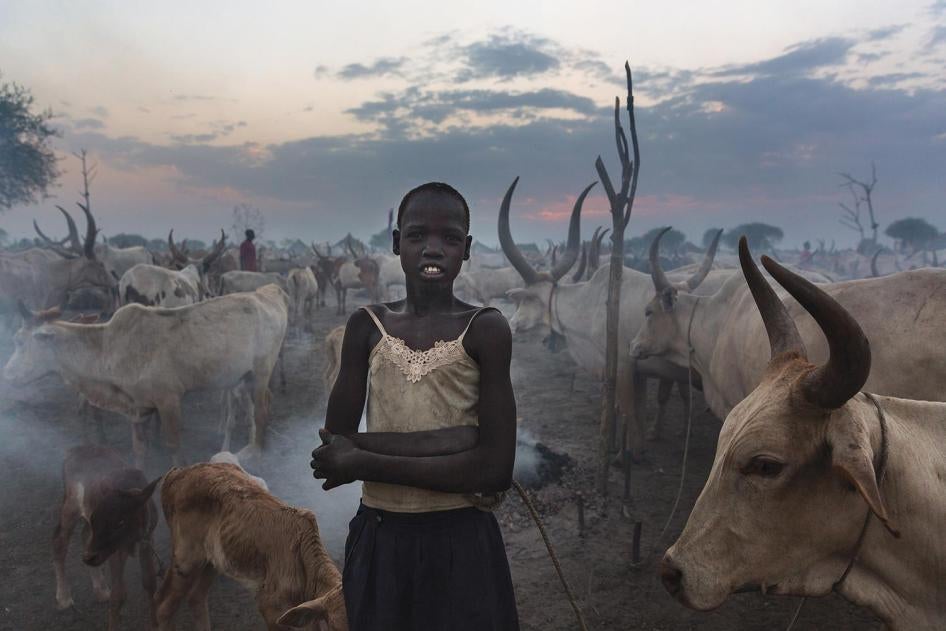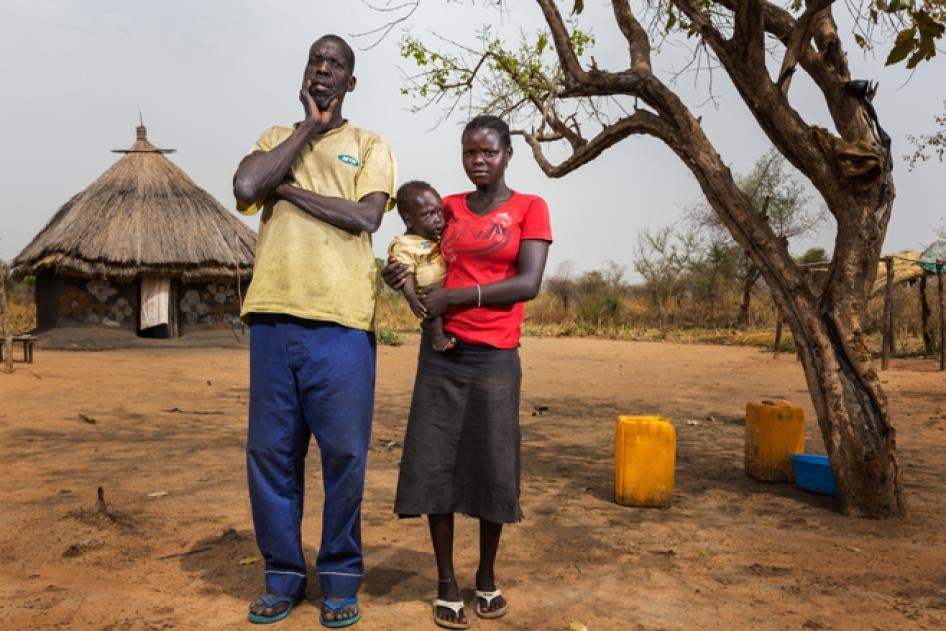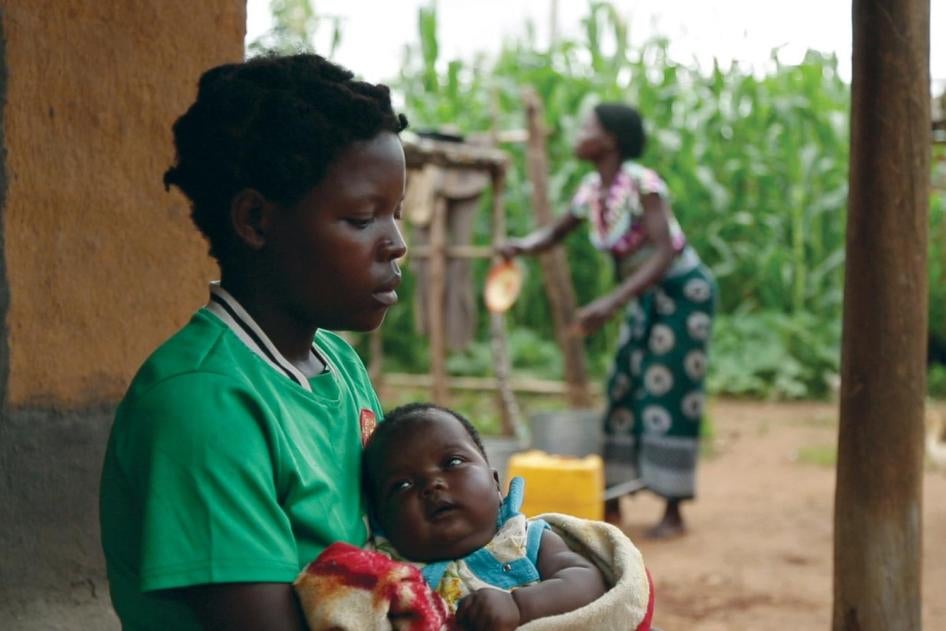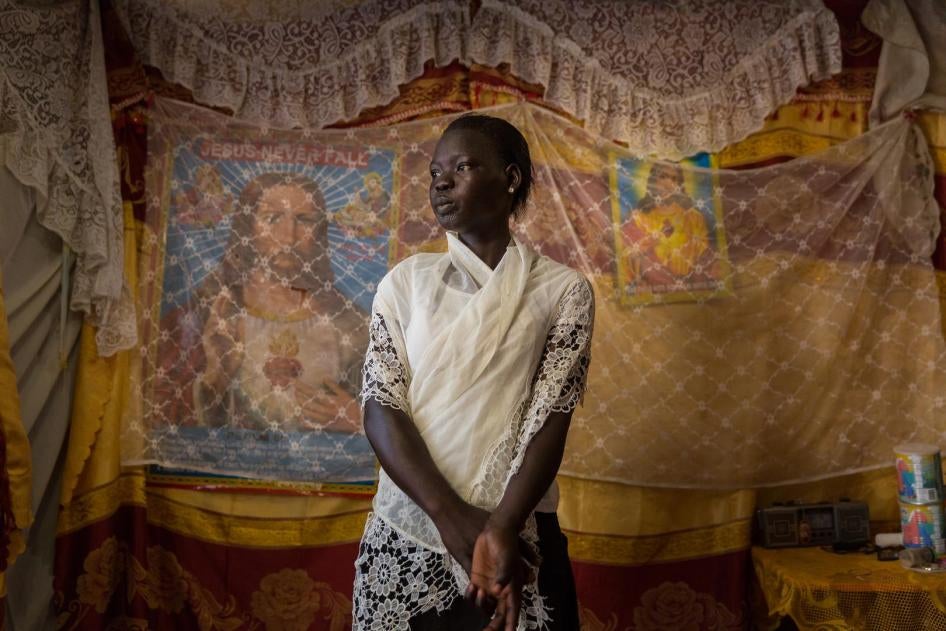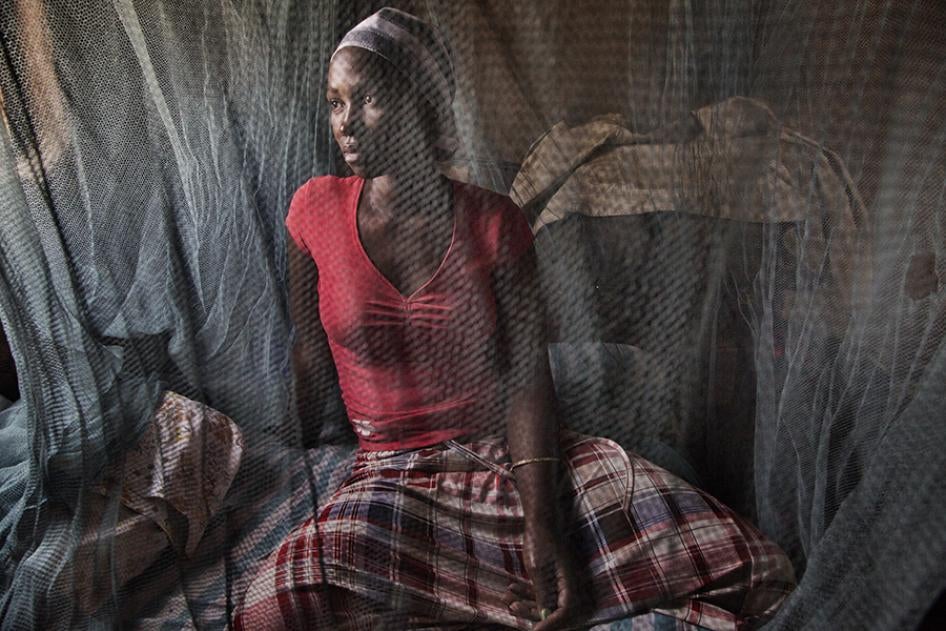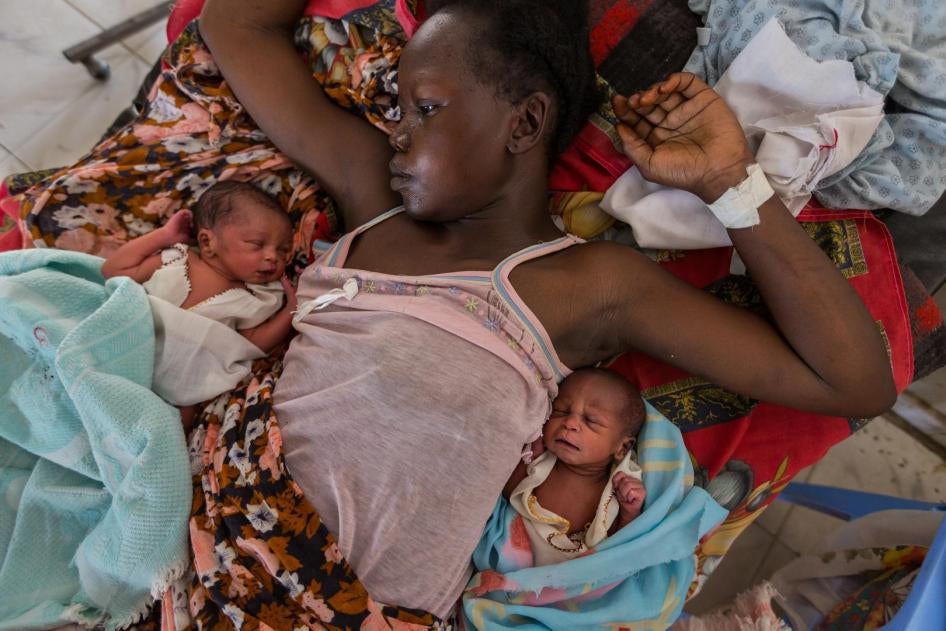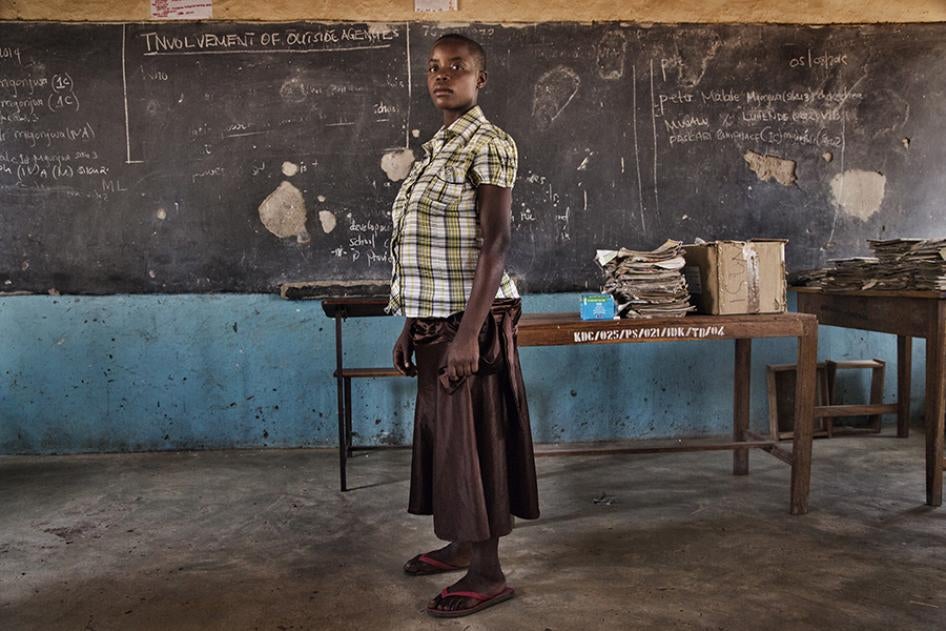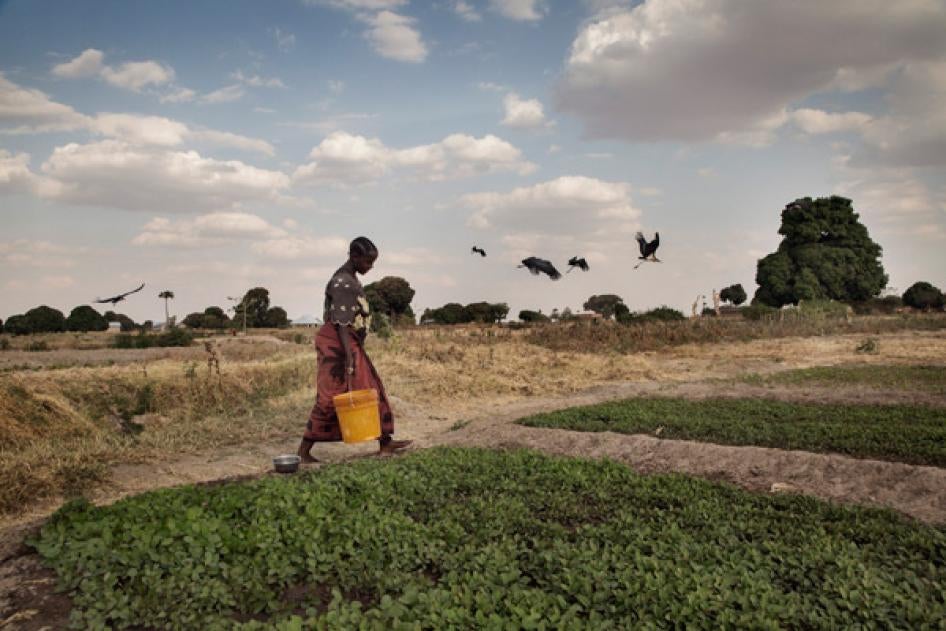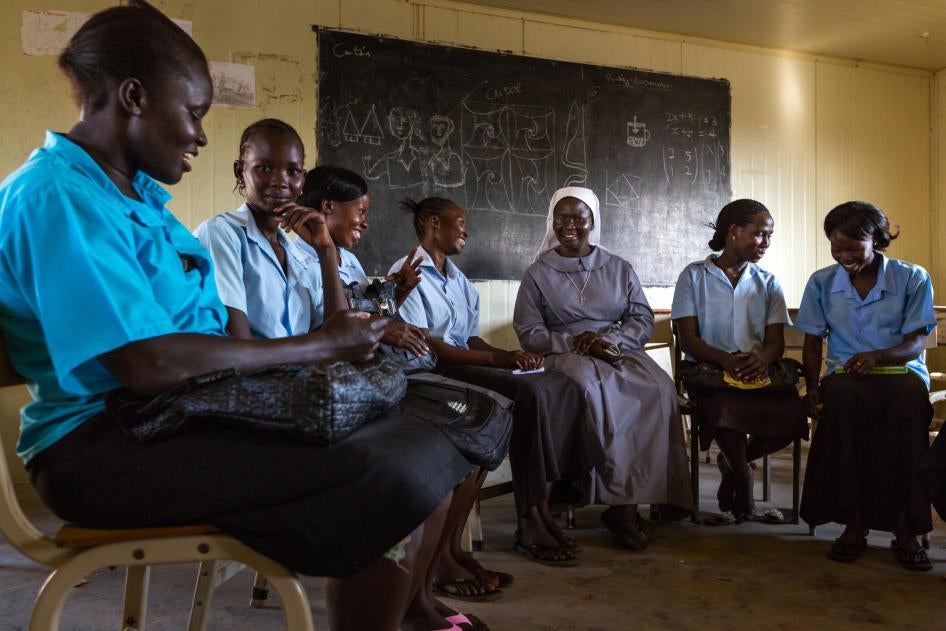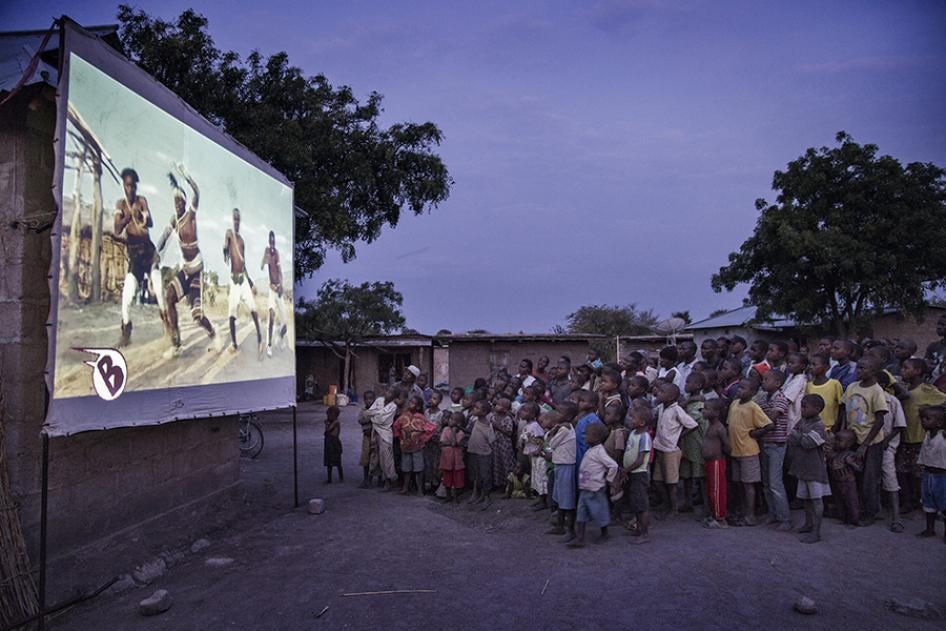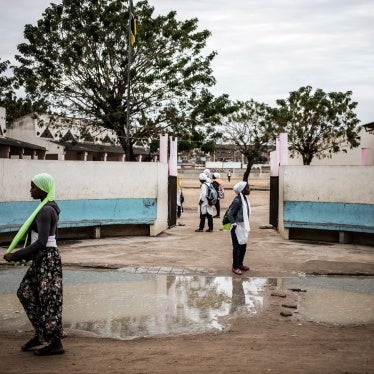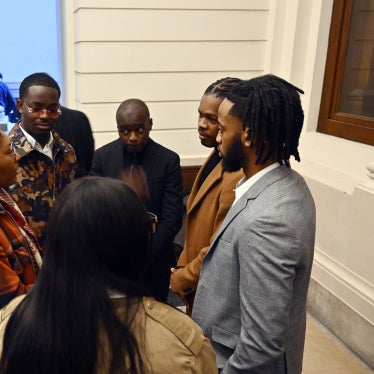Introduction
I faced a lot of problems in marriage. I was young and did not know how to be a wife. I was pregnant, had to look after my husband, do housework, deal with in-laws, and work on the farm. My worst time was when I was pregnant; I had to do all this and deal with a pregnancy while I was just a child myself.[1]
—Elina V., 19, married a 24-year-old man when she was 15, Mangochi district, Malawi, September 2013
We have a crisis on our hands. The UN estimates that 15 million girls experience child marriage each year…. We must move from vulnerability to voice and leadership. Africa is young and full of innovation. This energy must be harnessed to ensure that we have lasting solutions. [2]
—Nyaradzayi Gumbonzvanda, African Union Goodwill ambassador on Ending Child Marriage in Africa, national launch of the AU Campaign to End Child Marriage in Africa, July 31, 2015
In September 2015, leaders from Africa joined other governments from around the world in adopting the United Nations Sustainable Development Goals (SDGs), including a target to end child marriage in the next 15 years.
In sub-Saharan Africa, a staggering 40 percent of girls marry before age 18, and African countries account for 15 of the 20 countries with the highest rates of child marriage. [3] For example, 77 percent of girls in Niger,[4] and over 60 percent of girls in Central African Republic and Chad, marry before they turn 18.[5] Without progress to prevent child marriage, the number of girls married as children will double by 2050, and Africa will surpass South Asia as the region with the highest number of child brides in the world.
Girls who marry young are often denied a range of human rights: many must discontinue their education, face serious health risks from early and multiple pregnancies, and suffer sexual and domestic violence. Agenda 2063, the African Union’s 50-year action plan for development, recognizes that child marriage is a major impediment to regional development and prosperity. Countries lose out on potentially enormous social, economic, and political contributions these girls could make if given the right opportunities from the start.
At present, unprecedented attention is being paid to child marriage globally, including public commitments by heads of states to fight child marriage in their countries, as well as the support of international donors, UN agencies, and civil society groups.
African leadership is essential for harnessing this attention to effectively prevent and eliminate child marriage. Promising initiatives include the launch in Ethiopia on May 29, 2014 of a continent-wide campaign to end child marriage, and the appointments in Ethiopia of a new AU special rapporteur on child marriage, and of a Goodwill ambassador for the AU Campaign to End Child Marriage.
Most importantly, there must be concrete changes nationally and locally. There is no single solution for ending child marriage. Rather, to achieve this goal, African governments should commit to comprehensive change that includes a range of measures, including ensuring legal reform and enforcement, access to quality education, and sexual and reproductive health information and services; promoting girls’ empowerment; and changing harmful social norms.
What Perpetuates Child Marriage?
Evidence for what drives child marriage is growing. Despite diversity across regions and communities, many common threads lead to child marriage and its harmful consequences. Human Rights Watch research in Malawi, South Sudan, Tanzania, Zimbabwe, Afghanistan, Bangladesh, Nepal, and Yemen has found that intersections between gender discrimination and poverty; poor access to education and health services; customary practices; religious beliefs; and weak justice mechanisms fuel the practice.
Poverty
Pontinanta J. from South Sudan has nine siblings and neither of her parents is employed. She told Human Rights Watch that she was married in 2006 at the age of 13 because “my father did not want to pay my school fees. Sometimes we had no food at home.”[6] Aguet N., married at age 15 to a 75-year-old man said, “This man went to my uncles and paid a dowry of 80 cows. I resisted the marriage. They threatened me. They said, ‘If you want your siblings to be taken care of, you will marry this man.’ I said he is too old for me. They said, ‘You will marry this old man whether you like it or not because he has given us something to eat.’”[7]
Poverty is commonly cited by girls and family members as driving decisions to marry young. For poor families, with little money even for food and basic necessities, marrying their daughter early is an economic survival strategy: it means one less child to feed or educate. Girls themselves may see marriage as a way out of poverty. Discriminatory gender norms in many places, including traditions that mean girls go to live with their husbands’ families, while boys remain with, and financially support, their parents, also contribute to perceptions that girls are economic burdens. Some families believe that giving their daughter away in marriage may give her a chance for a better life.
Gaps in Laws and Enforcement
Legal frameworks play a powerful role in transforming norms and protecting girls’ rights. Relevant laws and regulations include those that set the minimum age for marriage at 18 for both girls and boys; requirements for birth and marriage registration; sexual violence and domestic violence laws; anti-corruption laws; and family status laws regulating marriage, divorce, custody, and inheritance. At least 20 African countries allow girls to marry below the age of 18 through their minimum age laws or through exceptions for parental consent or judicial approval.[8]
Although many African countries have established 18 as the minimum age of marriage for both boys and girls, weak enforcement has meant these laws have had little impact. Police may not have adequate training on dealing with these cases, do not see it as their job to prevent child marriages, or defer to the parents’ wishes. And while birth and marriage registration helps prove the age of spouses at the time of marriage, they are rarely produced or verified. For example, only 16 percent of children in Tanzania under age 5 have been registered with civil authorities, and only about half of these children received a birth certificate.[9] Birth certificates are often also forged by corrupt officials who may accept bribes and knowingly facilitate child marriages.
Corruption may mean girls can find little recourse from the justice system. A police officer from the Police Gender and Children’s Desk in Moshi, Tanzania, told Human Rights Watch that some of the cases taken to court for prosecution are delayed or are not completed because perpetrators pay money to the magistrates, who then postpone and adjourn cases indefinitely. The long delays eventually cause victims and witnesses to give up and stop coming to court.[10] Janet G., a child bride in Tanzania, said, “I want to report my husband’s abuse to the police but I do not have money to pay them to help me.”[11]
Also, many African countries have multiple legal systems where civil, customary, and religious laws overlap and generally contradict one another. Community or religious leaders who align child marriage with customary practices and religious beliefs may also resist laws and their enforcement.
Customary Practices and Religious Beliefs
Traditional beliefs about gender roles and sexuality and women and girls’ subordination undergird many customary practices, such as payment of dowry or bride price, which perpetuate child marriage. In a context of limited economic resources and opportunities, girls are often seen as economic assets whose marriages provide cattle, other animals, money, and gifts.
For example, dowry payment is a key driver of child marriage in South Sudan, where families see their daughters as sources of wealth. A marriage is sealed after a man and his family negotiates and pays a dowry to a woman’s family in the form of cattle, other animals, or, increasingly, money. Anita G., 19, told Human Rights Watch that her father forced her to leave school to get married when she was 16 and in her second year of secondary school: “My father said he did not have money to support my schooling. I then discovered that he had already received 20 cows as dowry for me. My mother tried to reason with my father to allow me continue with school, but my father said I had to marry. He said, ‘Once dowry has been taken, it cannot be returned.’”[12]
Religious beliefs can also be a driver of child marriage. Amongst Zimbabwe’s religious sects, particularly in the Apostolic faith where religion combines with traditional culture, girls often marry much older men at a very young age. A midwife in the Johwane Masowe Shonhiwa Apostolic faith told Human Rights Watch her church encourages child marriage: “Our church doctrine is that girls must marry when they are between 12 and 16 years old to make sure they do not sin by having sexual relations outside marriage. As soon as a girl reaches puberty any man in the church can claim her for a wife.”[13] Virginity testing and polygamy is also widely practiced within the Apostolic faith religious sects. Church doctrine enforced by elders, husbands, and other family members, prohibits married girls from continuing school.
Devastating Consequences
Human Rights Watch research has shown that child marriage has dire life-long consequences, often completely halting or crippling a girl’s ability to realize a wide range of human rights.
Child marriage directly violates rights to health, education, equality and non-discrimination, consensual marriage, employment, and to live free from violence and discrimination, which are enshrined in international human rights standards and institutions, including the Convention on the Elimination of All Forms of Discrimination against Women (CEDAW) and the Convention on the Rights of the Child (CRC).
Child marriage also violates the rights of women and girls that are enshrined in regional treaties. These include the Protocol to the African Charter on Human and People’s Rights on the Rights of Women in Africa (the Maputo Protocol), which calls on governments to “enact appropriate national legislative measures to guarantee that: the minimum age of marriage for women shall be 18 years”; and the African Charter on Human and Peoples’ Rights (the African Charter), which calls on states to “ensure the elimination of every discrimination against women and also ensure the protection of the rights of women and the child as stipulated in international declarations and conventions.”[14]
Maternal Mortality and Other Health Risks
I got complications during delivery. I was unable to push and I was weak with no energy. The nurses said I was getting complications because my body was not fully developed. To pull out the baby, the nurses forced their hands inside my body and pulled the baby out. I felt so much pain that I was not able to walk for a whole month after delivery.[15]
—Aisha S., married at 17, Kahama, Tanzania, April 2014
Child marriage is closely linked to early childbearing with consequences that can be fatal. Complications resulting from pregnancy and childbirth are the second leading cause of death among adolescent girls aged 15-19 years old globally.[16] Research shows that girls aged 10-14 are five times more likely to die during delivery than mothers aged 20-24; girls aged 15-19 are still twice as likely to die during delivery as women aged 20-24.[17]
These consequences are due largely to girls’ physical immaturity where the pelvis and birth canal are not fully developed. Complications in labor are exacerbated where emergency obstetric services are scarce, as is the case in many countries across the continent. In other cases, the stress of delivery in physically immature bodies can cause obstetric fistulas, a tear between a girl’s vagina and rectum that results in constant leaking of urine and feces. Girls suffering this condition are often ostracized and abandoned by their families and communities.
Limited access to reproductive health information and services for both unmarried and married adolescents contributes to these harms. Many adolescents have a limited understanding of sexual intercourse, its consequences, or contraception. Adolescent pregnancy outside of marriage, or the fear that adolescent girls will get pregnant, helps fuel child marriage. Once married, girls often do not have access to information or family planning services to delay or space pregnancies.
Many girls that Human Rights Watch interviewed in South Sudan lacked basic knowledge about sexuality and contraception. Gloria C. said she got pregnant at 14 or 15. “I didn’t know that I would get pregnant by having sex,” she said. “I was just playing sex.”[18] A problem in many countries is that many schools do not offer comprehensive sexuality education to girls and boys, or health workers do not share complete information about reproductive health with adolescents.
Halted Education
My father refused me to go to school. He said it is a waste of money to educate a girl. He said marriage will bring me respect in the community. Now I have grown up and I know that this is not true. I cannot get work to support my children and I see girls who have some education can get jobs.[19]
—Mary K., Yambio County, South Sudan, March 2012
Many girls who attend school are forced to leave due to marriage, pregnancy, or family pressure. Although school administrators and teachers should play a critical role in monitoring and encouraging married girls to remain in school, formal or informal school policies often mean that they instead stigmatize and expel them from the education system.
Others are pushed into marriage once they leave school. Poor access to quality education can also contribute to child marriage: when schools are too expensive, far, or poor quality, many families may pull their daughters out, leaving them at greater risk of marriage. Inadequate water and sanitation facilities can deter girls from attending school, especially once they begin menstruating. School fees, or even the costs of uniforms and school supplies, can put formal schooling beyond some families’ reach.
A lack of education limits girls’ choices and opportunities throughout their lives. The price of this exclusion is often poverty. Without education, girls and adult women have fewer opportunities to financially provide for themselves and their families. Research by the United Nations Children’s Fund (UNICEF) shows how limited education may make girls and women more vulnerable to persistent poverty when their spouses die, abandon or divorce them.[20]
In South Sudan, Anyier D., 18, told Human Rights Watch that her uncles forced her to leave school at age 14 in 2008 to marry an old man she did not know. She said: “I would wish to return to school even if I have children. People think that I am happy but I am not because I don’t have an education. I don’t have something of my own and I am only cleaning offices. If I had gone to secondary school, I would get a good job.”[21]
Sexual and Domestic Violence
I faced a lot of abuse in my marriage. My husband had an affair. He would beat me when he returned home. Whenever he was drunk, he would beat me for no reason. Every time he beat me, I would pack my clothes and go to my grandmother’s house but she did not help me. When I talked to my husband’s relatives, they used to tell me that that is how marriage life is and I should go back to my husband.[22]
—Chanika B., married when she was 15, Mangochi district, Malawi, September 2013
Child marriage exposes girls and young women to violence, including marital rape, sexual and domestic violence, and emotional abuse. Rose M., a mother of two, was married when she was 16. She told us: “I experienced a lot of problems in my marriage. We had no food or clothes. We washed our clothes with leaves. My husband beat me at least twice a week and he used to force me to have sex with him. Also, I was not allowed to go out of the home.”[23]
While not all child marriages are marked by domestic violence, the risks increase when there are large gaps in age between a girl and her husband.[24] Many countries fail to criminalize marital rape, and even when it is a crime, child brides have little ability to seek help. Married girls and young women between the ages of 15 and 19 with low levels of education are at a much greater risk of domestic and sexual violence from their spouses than older and more educated women.[25]
A study across seven countries found that girls who married before the age of 15 were more likely to experience spousal abuse than women who married after 25.[26] Limited information about their rights, lack of access to services—especially legal assistance; discriminatory divorce, inheritance, and custody laws; and rejection from their own families—can leave many trapped in abusive marriages with no means of escape. A lack of understanding and access to information on healthy relationships, reproduction, and sexual intercourse among both boys and girls contributes to abusive relationships.
Lack of shelters is a key obstacle to effectively responding to child marriages. Many governments lack shelters or safe spaces where girls can seek protection and help when at risk of child marriage, or when they run away from them.
The Way Forward
While the harms caused by child marriage are grim, the benefits of ending the practice are transformative and far-reaching. Tackling child marriage is a strategic way to advance women’s rights and empowerment in several areas, ranging from health, education, work, freedom from violence, and participation in public life.
In order to do so, it is essential that all relevant stakeholders—including community and religious leaders; school teachers and administrators; health care workers; police, prosecutors, and the judiciary; government officials; media; parents, and of course, girls and boys—understand and commit to their role in ending child marriage.
The absence of comprehensive national strategies on child marriage and poor coordination among government ministries and agencies undermines the effectiveness of government efforts. Without clear guidelines on how authorities should handle cases of child marriage, government responses remain fragmented.
For example, in Malawi, various government entities, officially coordinated by the Ministry of Gender, Children and Community Development, are mandated to tackle violence against women, including child marriages. The Ministry of Justice is responsible for the prosecutors, the Ministry of Gender, Children and Community Development for child protection workers, and the Ministry of Interior for the police. However, there is little communication or formal referrals on specific cases among these entities.
Similarly, the AU has launched disparate campaigns and initiatives that address child marriage but has not coordinated them, for example, the Campaign for Accelerated Reduction of Maternal Mortality (CARMMA), the African Women’s Decade, and the African Youth Decade Plan of Action.
Effective solutions require coordination by multiple actors and must put girls’ empowerment and voice at their center. Regional and international institutions, governments, and civil society groups should work together to ensure that the SDG target of ending child marriage by 2030 is achieved.
Recommendations
To the African Union
- Ensure a coordinated and comprehensive approach among child marriage initiatives, including the Campaign for Accelerated Reduction of Maternal Mortality (CARMMA), the African Women’s Decade, and the African Youth Decade Plan of Action.
- Incorporate an indicator to monitor progress towards ending child marriage into the AU Agenda 2063.
- Incorporate child marriage into the work of the African Regional Economic Communities (RECs) and the inclusion of an end to child marriage into its development strategies.
- Urge governments to develop comprehensive national strategies for combating child marriage, help share best practices regionally, and support programs to implement these strategies.
To Heads of State and Government and Parliaments
- Set 18 as the national minimum age of marriage for both boys and girls and develop strategies and training for enforcement.
- Enact marriage laws that include provisions that establish free and full consent of both spouses, requirements for proof of age before marriage licenses are obtained, and penalties for violence or intimidation against anyone who refuses to marry.
- Ratify the Maputo Protocol.
- Ensure access to reproductive information and healthcare for all girls and women in rural and urban areas by allocating greater resources from national health expenditure.
- Provide access to information to parents, guardians, and community leaders about the harmful effects of child marriage, for example, by initiating a nationwide awareness campaign against child marriage, emphasizing the health risks of early pregnancy, the benefits of girls’ education, the law prohibiting child marriage, consequences for those who break the law, and the mechanism for reporting child marriage and obtaining assistance.
- Implement nationwide programming to empower girls. Build on best practices by providing economic incentives and support to girls’ families coupled with designing programs tailored to local communities that provide girls with safe spaces and equip girls with information about the harms and illegality of child marriage, awareness about sexual and reproductive health, including menstrual hygiene management, skills training, career guidance, and support networks.
To National Ministries of Education
- Ensure girls’ access to quality education, including secondary education, by:
- Committing the resources necessary to guarantee access to free, compulsory primary education for all girls and boys.
- Developing retention strategies, such as incentives for families to keep girls in school, offering scholarships, expanding school feeding programs, ensuring schools have adequate sanitation facilities, and offsetting the costs of secondary school by subsidizing or eliminating costs of uniforms, exams, and textbooks.
- Develop retention strategies and life skills programs for married girls through targeted outreach and support programs, initiating evening or part-time formal schooling and vocational training opportunities, and following up with students who drop out of school.
- End the discriminatory practice of mandatory pregnancy testing of girls, expelling pregnant girls from school, and excluding married students from school.
- Empower girls and boys with information and knowledge of their reproductive and sexual rights by introducing comprehensive sex education curriculum.
To National Ministries of Health
- Develop and implement a national policy and strategy on adolescent reproductive health with a strong focus on the right to health information and services, including contraception; address factors that contribute to unplanned pregnancies; and train health workers on engaging adolescents.
- Improve access to emergency obstetric care including monitoring of labor, trained birth attendants, newborn care, and contraception.
To National Ministries of Justice and Home Affairs
- Provide regular training for police and prosecutors on their legal responsibilities to investigate and prosecute violence against women, including child marriage.
- Ensure that police and prosecutors investigate and prosecute forgeries of birth or marriage certificates under the applicable law.
Authored by Annerieke Smaak and Nisha Varia
Reviewed by Dewa Mavhinga and Agnes Odhiambo
Edited by Clive Baldwin, Zama Coursen-Neff, Liesl Gerntholtz, and Danielle Haas
[1] Human Rights Watch interview with Elina V., Mangochi district, Malawi, September 21, 2013.
[2] African Union, “The Republic of Zimbabwe Launches AU Campaign to End Child Marriage in Africa,” August 2, 2015, http://sa.au.int/en/content/republic-zimbabwe-launches-au-campaign-end-child-marriage-africa (accessed November 13, 2015).
[3] UNICEF, Ending Child Marriage: Progress and Prospects, 2014, http://data.unicef.org/corecode/uploads/document6/uploaded_pdfs/corecode/Child-Marriage-Brochure-HR_164.pdf (accessed November 15, 2015). While sub-Saharan Africa has the highest rates of child marriage, due to population size, the largest number of child brides reside in South Asia.
[4] Ibid.
[5] Ibid.
[6] Human Rights Watch interview with Pontinanta J., Yambio County, South Sudan, March 7, 2012.
[7] Human Rights Watch interview with Aguet N., Bor County, South Sudan, March 15, 2012.
[8] Belinda Maswikwa et al., “Minimum Marriage Age Laws and the Prevalence Of Child Marriage and Adolescent Birth: Evidence from Sub-Saharan Africa,” International Perspectives on Sexual and Reproductive Health, (2015) vol. 41(2):58–68, http://www.guttmacher.org/pubs/journals/4105815.pdf (accessed November 13, 2015); Girls Not Brides, “Minimum Age of Marriage in Africa,” Compiled by the African Child Policy Forum (ACPF), 2013, http://www.girlsnotbrides.org/wp-content/uploads/2013/04/Minimum-age-of-marriage-in-Africa-March-2013.pdf (accessed November 13, 2015).
[9] Tanzania National Bureau of Statistics and ICF Macro, “Tanzania Demographic and Health Survey 2010,” 2010, http://dhsprogram.com/pubs/pdf/FR243/FR243%5B24June2011%5D.pdf (accessed November 10, 2015), p. 27.
[10] Human Rights Watch interview with Happiness Eliufoo, police officer at the Police Gender and Children’s Desk, Hai police station, Moshi, Tanzania, April 2014.
[11] Human Rights Watch interview with Janet G., Mwanza, Tanzania, March 31, 2014.
[12] Human Rights Watch interview with Anita G., Kahama district, Tanzania, April 2, 2014.
[13] Human Rights Watch interview with C.M, midwife in the Johwane Masowe Shonhiwa Apostolic faith sect, Masvingo, Zimbabwe, October 14, 2015.
[14] Protocol to the African Charter on Human and Peoples’ Rights on the Rights of Women in Africa (the Maputo Protocol), art. 6(b); African (Banjul) Charter on Human and Peoples’ Rights (ACHPR), OAU Doc. CAB/LEG/67/3 rev. 5, 21 (1982), art. 18. The Maputo Protocol in article 6 calls on governments to develop laws that establish 18 as the minimum age of marriage. The African Charter in article 18 obligates governments to “ensure the elimination of every discrimination against women and also ensure the protection of the rights of the woman and the child as stipulated in international declarations and conventions.”
[15] Human Rights Watch interview with Aisha S., Kahama, Tanzania, April 2, 2014.
[16] UN Women, “Child Marriages: 39,000 Every Day – More than 140 million girls will marry between 2011 and 2020,” March 7, 2013, http://www.unwomen.org/en/news/stories/2013/3/child-marriages-39000-every-day-more-than-140-million-girls-will-marry-between-2011-and-2020 (accessed November 13, 2015).
[17] World Health Organization (WHO), “WHO Guidelines on Preventing Early Pregnancy and Poor Reproductive Outcomes Among Adolescents in Developing Countries,” 2011, http://whqlibdoc.who.int/publications/2011/9789241502214_eng.pdf (accessed November 10, 2015), p. 2.
[18] Human Rights Watch interview with Gloria C., Yambio County, South Sudan, March 7, 2012.
[19] Human Rights Watch interview with Mary K., Yambio County, South Sudan, March 7, 2012.
[20] UNICEF Innocenti Digest, “Early Marriage Child Spouses,” No. 7, March 2001, http://www.unicef-irc.org/publications/pdf/digest7e.pdf (accessed November 13, 2015), p.12.
[21] Human Rights Watch interview with Anyier D., Bor County, South Sudan, March 15, 2012.
[22] Human Rights Watch interview with Chanika B., Mangochi district, Malawi, September 21, 2013.
[23] Human Rights Watch interview with Rose M., Kahama district, Tanzania, April 2, 2014.
[24] UN Women, “Child Marriages: 39,000 Every Day – More than 140 million girls will marry between 2011 and 2020,” March 7, 2013, http://www.unwomen.org/en/news/stories/2013/3/child-marriages-39000-every-day-more-than-140-million-girls-will-marry-between-2011-and-2020 (accessed November 13, 2015).
[25] WHO, “Multi-country Study on Women’s Health and Domestic Violence against Women: Initial Results on Prevalence, Health Outcomes and Women’s Responses: Summary Report,” 2005, http://www.who.int/gender/violence/who_multicountry_study/summary_report/summary_report_English2.pdf (accessed November 16, 2015), p. 8. The multi-country study found that in all the countries studied, except Japan and Ethiopia, girls in this age bracket were more vulnerable to physical and sexual abuse by a partner, non-partner, or both, than older women.
[26] Sunita Kishor and Kiersten Johnson, “Profiling Domestic Violence: A Multi-Country Study,” Measure DHS+ ORC Macro, June 2004, http://dhsprogram.com/pubs/pdf/od31/od31.pdf (accessed November 13, 2015), p. 29.
